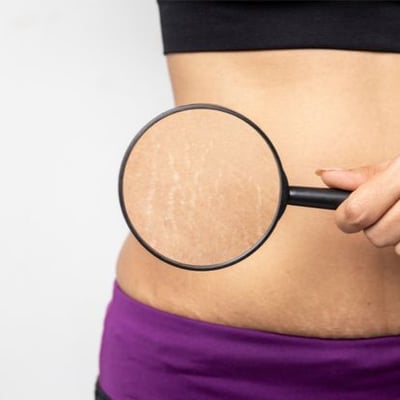 OVERVIEW
OVERVIEW
Stretch marks are medically termed “striae” and are scars on the skin. They appear in areas of the skin that have stretched to grow and expand the body. They don’t cause harm or pain, but some people don’t like how they look on the skin and may feel self-conscious about their stretch marks. They appear as indented streaks, lines, or stripes on the skin and can be pink, black, blue, red, or purple. Stretch marks usually fade over time to be less noticeable but can cover a large area of the body.
What Causes Stretch Marks?
Stretch marks form when the skin stretches quickly, and the collagen and elastin proteins in the skin can’t support the rapid change. Pregnancy, puberty, and obesity are the most common causes of stretch marks because they are times when the skin adapts and stretches most rapidly. Kids can develop stretch marks during other periods of rapid growth, but especially during puberty.
Certain diseases, such as Cushing Syndrome and Marfan syndrome are more likely to cause stretch marks. The use of corticosteroids for medication may make the skin thinner and more prone to stretch marks, and hormonal fluctuations may play a role in developing stretch marks. Bodybuilding and rapid muscle gain have also been known to cause stretch marks.
Where are Stretch Marks Commonly Found?
Stretch marks are most common in females but also affect males. They may show up more clearly on darker skin tones. They can be found in many areas of the body but typically appear in areas with more body fat. Areas of the body where stretch marks commonly appear include the abdomen, breasts, hips, thighs, and buttocks. Stretch marks generally appear on pregnant women in the third trimester of pregnancy and seem to occur more frequently in pregnancies of younger women.
Most Common Treatments for Stretch Marks
Many stretch marks will naturally fade with time, but options for treatment include:
Topical Creams
Creams that contain tretinoin and glycolic acid may help reduce the appearance of newer stretch marks, but tretinoin may make skin appear red, irritated, or flaky. Creams seem to work best on newer stretch marks and may have to be used for weeks before you can see a difference.
Laser Treatments
Laser treatments may help fade the appearance of stretch marks. Dermatologists use ablative (removes the top layer of skin) and non-ablative (doesn’t remove the top layer of skin) lasers to treat stretch marks. Multiple sessions would likely be necessary to see results.
Microdermabrasion
Microdermabrasion breaks up the top layer of skin and helps tighten collagen and elastin fibers in the skin. It doesn’t guarantee results but may help.
Home treatments
Makeup and self-tanner can help disguise the appearance of stretch marks but tanning the skin in the sun can make stretch marks contrast more dramatically with the regular skin color. Some people believe that vitamin E, shea butter, or cocoa butter can help prevent or lessen the appearance of stretch marks, but the benefits are unclear.

 OVERVIEW
OVERVIEW
